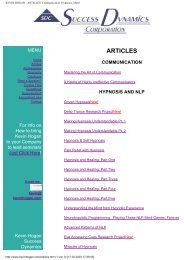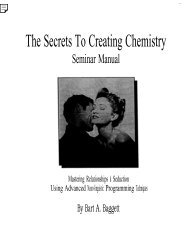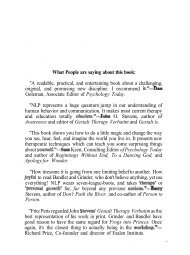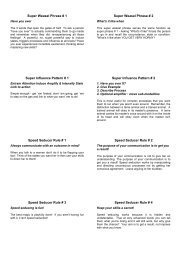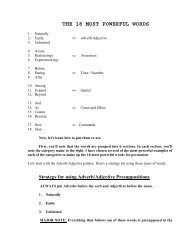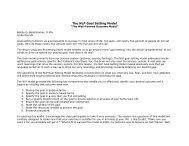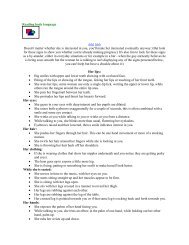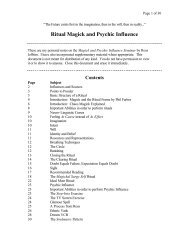A Pragmatic Guide To Communication & Change.pdf - NLP Info Centre
A Pragmatic Guide To Communication & Change.pdf - NLP Info Centre
A Pragmatic Guide To Communication & Change.pdf - NLP Info Centre
- No tags were found...
Create successful ePaper yourself
Turn your PDF publications into a flip-book with our unique Google optimized e-Paper software.
Watzlawick, et al., <strong>Pragmatic</strong>s of Human <strong>Communication</strong><br />
In dealing with communication, it is important to note the distinction made by<br />
Walzlawick, that all behavior is communication. There are actually two kinds of<br />
communicative behavior. One encompasses observable patterns of interaction, primarily<br />
speech and overt gestures. The other is less obvious communication that goes on inside<br />
each of us all the time. All communication, whether overtly exhibited or internally<br />
experienced, affects us in observable ways. It is the observation and utilization of specific<br />
communicative behaviors that make up the major theme of this book.<br />
Once we begin to explore the ways we make sense of the myriad experiences we call<br />
"living," many behavioral patterns become evident. Grinder and Bundler's "human<br />
modeling processes" afford us an organizational basis from which to explore differences<br />
between what people experience (the territory) and how they make sense of those<br />
experiences (their map or model of the world).<br />
Supported by evidence from neurological studies, we extend this model-building<br />
behavior to include three constraints: neurological, social, and individual. By under<br />
standing that these mechanisms are important in the creating of an individual's model and<br />
in that person's representation of "who" he is, we begin the first step in gaining the<br />
rapport and trust so important to influential and therapeutic communications.<br />
Recognizing that each person creates a different model of the world enables us to cherish<br />
rather than judge or fear those differences. It is those differences that make each of us<br />
unique and create the amazing and wonderful diversity of personality we encounter<br />
within and between societies.<br />
We share a universal linguistic convention: understanding<br />
I do not attempt to define what a human being is, I describe what a human being does. (p.<br />
30) Bois, The Art of Au areness<br />
26<br />
in the 4-tuple. For simplicity, the model below shows a complete set of synthesized<br />
experiences riding atop the external 4-tuple.<br />
As we shall see in later chapters, people can systematically delete one particular<br />
element from their 4-tuples. The ability of a therapist to detect and utilize this kind of<br />
information when working with an individual can greatly expedite the process of<br />
therapeutic growth and change. The example on page 123 demonstrates how this<br />
information can be effectively used.<br />
As the figure shows, the 4-tuples are finally collected in the Memory Box. The<br />
repository for all experiences, it represents our personal history, our composite model<br />
of the world. This collection of experiences does much to shape our thinking and our<br />
perception of the world around us. <strong>Info</strong>rmation for synthetic experiences in this<br />
simplistic diagram comes from the Memory Box through the Memory Tube. Again, this<br />
information can be in the form of a complete internally generated 4-tuple, or it can be<br />
single elements from the various stored 4-tuples which "replace" one or more of the<br />
pieces of external origins.<br />
A complete diagram showing all three processes is presented in Appendix A.<br />
Figure I - 3<br />
2,<br />
When we communicate with people, when we are successful in creating therapeutic<br />
changes, or in teaching something new, we always begin at the neurological level with<br />
the sound of our voices and the look and feel of our actions. When intervention ocurs at



